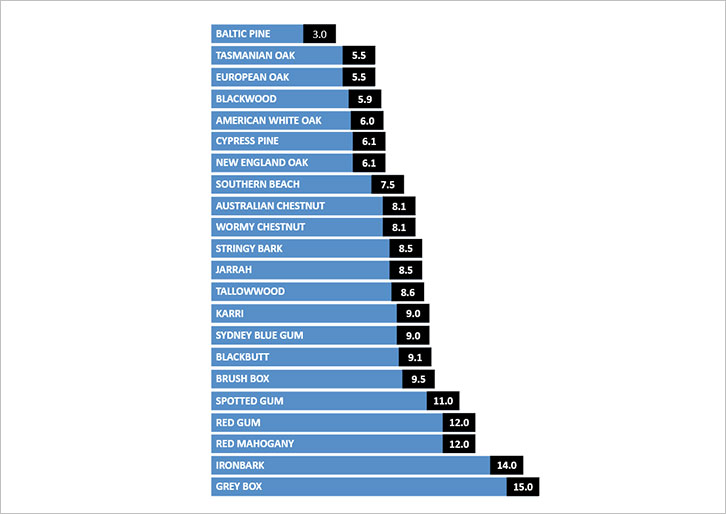Please read the product information guides below before purchasing your product and commencing installation.
Please contact us via e-mail if you have any issues opening any links or understanding.
Please Note:
The information supplied on this page has been provided to assist with projects to help your product perform well over time. In cases refunds or return are not available after pick-up or delivery, as we can not monitor the environment the timber is in. Refunds do not have to be accepted for change of mind. Nationwide Timber is the supplier only and take no legal liability.
For full details on Nationwide Timber’s policies, please go the following pages:
Refund, Exchange and Issue Policy

Select Grade AS 2796 – providing a floor where the feature present or natural discolouration will not dominate the appearance of the floor. Features that are permitted still include short narrow gum veins, a limited number and size of past borer activity and small tight knots.
Standard Grade AS 2796 – providing a floor that may have significantly more character than a Select Grade floor. To some degree this will depend on the features present in a particular species. In one species gum veins may naturally be prevalent while in another there may be few gum veins but past borer activity may be more prevalent. Therefore, this grade can be expected to have greater character than Select Grade, and contain an increased amount of gum vein, past borer activity, tight knots and natural discolouration.
Feature Grade AS2796 – providing for a floor that contains boards with similar features to Medium Feature – Standard Grade but where the length of features such as gum veins may be longer and past borer activity may be more frequent. Again depending on the species, features will vary and in some instances boards meeting high feature grade may only appear moderately featured.
Cover Grade – This grade contains more than the permissible number of natural features and shorter lengths. Cover grade will contain miss-machining/manufacturing defaults, and can contain large amounts of gum vein, knot holes and other natural features such as holes.
– Feel free to discuss with our team.
Prestige Grade – is best referred to as a mixture of select and standard grade.
Rustic Grade – is best referred to as a mixture of feature grade and standard grade.
Prior to purchasing our timber, you must read and follow the ATFA Decking Guide and other links below to ensure safe storage, expectation and having a well performed deck.
External decking timbers exposed to the weather will reach Equilibrium Moisture Content (EMC) with their surroundings after a period of 9-18 months, depending upon prevailing weather, size and type of timber used.
On-Site Storage
Timber delivered to site should be stored supported on level bearers not less than 150 mm clear of the ground. Timber should be left block stacked and banded until required. Decking should be covered and stored to protect it from the sun and rain.
End-Plating and Sealing
All decking should be coated with either a suitable water based or oil on all four sides before installation. To reduce end splitting in timber, the end grain should be coated immediately after sawing with a suitable sealer.
Fasteners
All fixings (nails, bolts, screws, plates, etc.) should be either stainless steel, monel metal, hot dipped galvanised or mechanically plated. Consider heavy gauge screws such as bugle screws.
Pre-drilling
Pre-drilling for screws or nails may be necessary to avoid splitting. Where pre-drilling for screws or nails is required, the pre-drilled hole should be approximately 80% of the shank diameter of the screw or nail. The size of fastener required to fix the decking boards may dictate the minimum deck joist thickness.
Joint Detailing
The design of the joints is a key factor in ensuring the durability of the structure. When designing joints in timber decks, the following general guidelines should be considered:
Ventilation
The performance of the decking and timber substructure can be markedly enhanced by ensuring adequate ventilation. Care should be taken to avoid dead air pockets. The wider the decking board spacing and the greater the ventilation, the longer the deck will last. As a minimum, a final decking board spacing of 6 mm is recommended. Not allowing adequate ventilation and air-flow will cause cupping of boards.
Maintenance
Maintenance must be up kept for the presentation of the timber and will also assist in the overall look as well as helping the deck’s stability.
For Merbau specific, and an example on all timbers, see this link.
BAL and Janka ratings on this website are taken from Wood Solutions, an industry initiative designed to provide independent, non-proprietary information about timber and wood products.